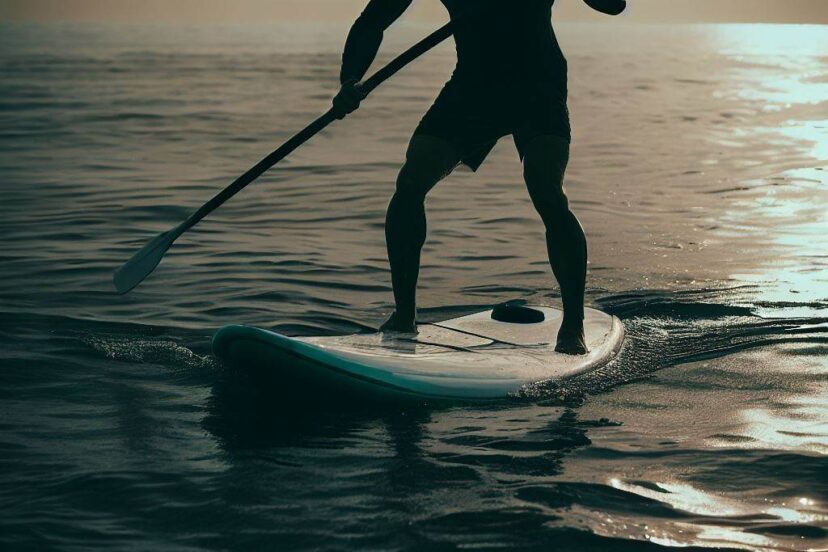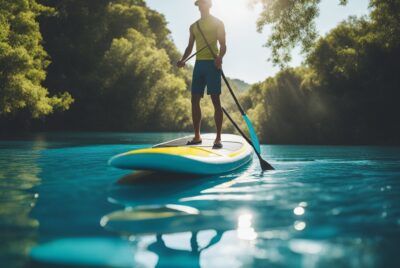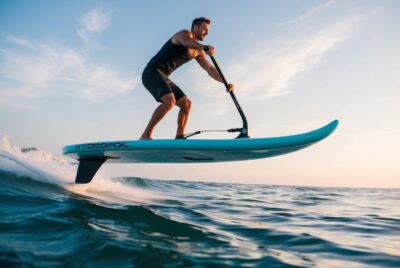Hard Paddle Boards: The Enduring Allure
*We may earn a commission for purchases made using our links. Please see our disclosure to learn more.
The Enduring Allure of Hard Paddle Boards
Drifting gracefully over the water’s surface, feeling every ripple and wave beneath you, the sensation is unmatched — and it’s primarily credited to the firm structure of hard paddle boards. Favored by many for their stability, performance, and timeless appeal, these boards offer an unparalleled paddle boarding experience that both beginners and pros swear by.
Dive in as we explore the world of hard paddle boards and what makes them a top choice for enthusiasts around the globe.
The Basics: What are Hard Paddle Boards?
Often referred to as rigid or solid boards, hard paddle boards offer a firm structure that, for many enthusiasts like me, provides a unique and unrivaled experience on the water.
Materials and Construction
Most hard paddle boards are crafted from foam cores wrapped in layers of fiberglass or carbon fiber. This provides a perfect blend of strength and lightness. Ever wonder why these boards have that beautiful shine? That’s the epoxy resin coating!
Sizes and Shapes
From racing to surfing, and even just leisure paddling, there’s a shape and size for every activity. My first was a 10-foot all-rounder – perfect for a beginner!
Why Choose a Hard Paddle Board?
You might ask, with the rise of inflatable boards, why go hard? Well, my friend, let me enlighten you.
Performance Advantages
Ever tried catching a wave on an inflatable? Hard boards, with their solid construction, allow for sharper turns and better maneuverability. Perfect for cutting through choppy waters!
Durability and Longevity
While they might require a bit more care, these boards are built to last. No worries about punctures or leaks here!
Aesthetic and Feel
Admit it, there’s something undeniably stylish about a shiny hard paddle board. Plus, the solid feel underfoot? Unbeatable.
Hard Paddle Boards: Connect with Nature
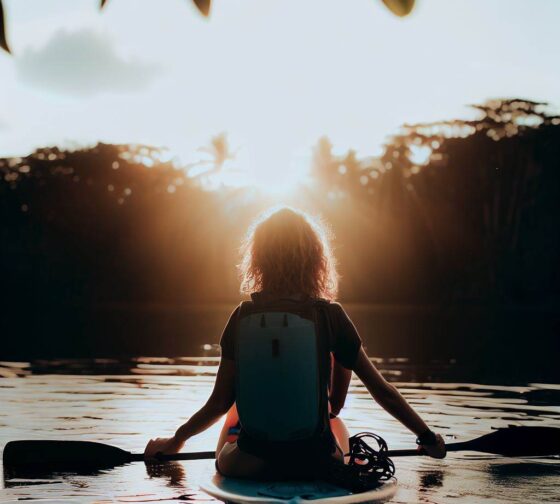
There’s something incredibly serene about standing atop a hard paddle board, gently floating on the water, feeling the ripples below and hearing the rhythmic splash of your paddle. The sun warms your skin, birds glide overhead, and the horizon stretches endlessly before you.
Paddle boarding, especially on a rigid board, lets you connect with nature in a way few other activities can. I’ve often found moments of profound clarity and peace during these sessions. It’s not just a sport; it’s a form of meditation.
When the water’s surface mirrors the sky, creating a seamless blend of blues, and your board becomes the thin line connecting the vast expanse above and below, you truly realize the beauty and vastness of our natural world.
Community and Camaraderie
Another overlooked aspect of paddle boarding, particularly with hard boards, is the community it fosters. On countless occasions, I’ve struck up conversations with fellow enthusiasts at the beach or during events. We’d chat about our boards, share tips, or even just discuss the best spots to catch a sunset.
Owning a hard paddle board often becomes an entry ticket to this welcoming community. Whether it’s group paddles, races, or eco-clean up events, the paddle boarding community is always buzzing with activity.
Joining this world doesn’t just give you a new hobby; it introduces you to a family of passionate individuals who share the love for the waves, the thrill of the ride, and the peace that comes with
Hard Boards vs. Inflatable Boards: A Quick Comparison
- Hard Boards:
- Pros:
- Better performance: Ideal for fast paddling and wave surfing.
- Durability: Less prone to punctures or leaks.
- Stability: Generally provide a sturdier feel underfoot.
- Cons:
- Portability: More challenging to transport without a vehicle.
- Storage: Requires more space and careful handling to avoid dings.
- Pros:
- Inflatable Boards:
- Pros:
- Portability: Easily deflated and packed into a backpack.
- Storage: Compact when deflated; ideal for limited storage spaces.
- Versatility: Suitable for various water conditions.
- Cons:
- Performance: Often slower and less agile than hard boards.
- Vulnerability: Susceptible to punctures, though many are quite durable
- Pros:
Top 5 Brands for Hard Paddle Boards
- Starboard: Renowned globally, Starboard offers a diverse range of SUPs, including high-performance hard boards. Their constructions often lead the industry in terms of innovation and sustainability.
- BIC Sport: BIC is not just about pens; their watersports division has been making waves (pun intended) for years. BIC Sport SUPs are known for their durability and user-friendly designs, making them popular among beginners and schools.
- Isle Surf and SUP: A brand created by surfers and paddlers, Isle offers a range of paddle boards, including some top-notch hard boards. They emphasize sustainability and often incorporate user feedback into their designs.
- Naish: Founded by world champion windsurfer Robby Naish, this brand is synonymous with watersports. Naish SUPs are known for their performance, quality, and cutting-edge designs.
- NSP (New Surf Project): With a strong emphasis on sustainable production, NSP offers a range of paddle boards, including performance-oriented hard boards. They often utilize innovative materials and processes in their board constructions.
Hard Paddle Boards: Tips for First-Time Buyers
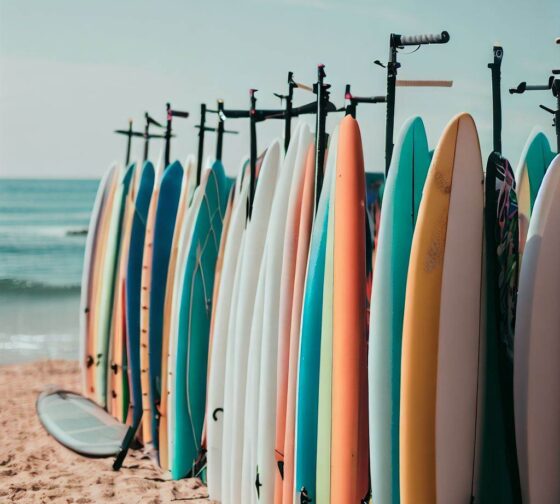
I remember the first time I bought a hard board – overwhelming, right? Let me share some tidbits to make your choice easier.
Assessing Your Skill Level
Beginner? Opt for a wider board for stability. Advanced? Maybe a narrower, sleeker board for speed.
Board Length and Thickness
Remember, longer boards glide faster, but shorter ones turn better. And thickness? It affects your board’s volume and buoyancy.
Fin Configurations
Single, twin, thruster… each setup has its perks. I started with a single fin and gradually experimented. Adventure, right?
Hard Paddle Boards: How to Care
Treat your board right, and it’ll be your loyal companion for years.
Proper Storage: Always store it in a cool, shaded area. And those board bags? Worth every penny for protection.
Regular Maintenance: A quick rinse after each use, regular checks for dings, and maybe even a fresh coat of wax – your board will thank you!
Hard Paddle Boards: Conclusion
Hard paddle boards, with their unmatched performance, durability, and style, are a gem in the paddle boarding world. Whether you’re catching waves, racing, or just enjoying a serene paddle at sunset, there’s a hard board out there with your name on it. Dive in, paddle on, and enjoy the ride!
FAQs
- Is a hard paddle board better than an inflatable?
- It depends on your needs! Hard boards offer better performance, while inflatables are more portable.
- How do I transport my hard paddle board?
- Roof racks or trailers work best. Remember to secure it properly!
- What’s the best size for a beginner?
- Generally, a board around 10-11 feet with good width for stability.
- Do hard paddle boards require a lot of maintenance?
- Not excessively! Regular rinsing and occasional checks should suffice.
- Can I use my hard paddle board for yoga?
- Absolutely! Just ensure it’s wide and stable enough for your poses. Namaste!

